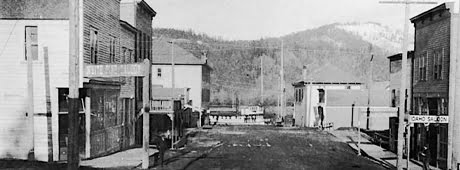No products in the cart.
St. Maries—Spotlight

Loggers at Loggerheads
By George Currier
Back in October 2002, IDAHO magazine published a Spotlight City feature on the northern town of St. Maries. This revisit includes the author’s take on a seminal loggers’ strike of the early 20th Century.
Bud’s Drive In was a nondescript restaurant of one story with what appeared to be a kitchen window cut head-high into the street-side wall. The purpose of this window was to serve patrons who didn’t come inside but instead pulled up in automobiles via the short driveway parallel to the street.
They would drive up and holler their order to a server, who would lean out to take it and eventually hand the food out to them. This kitchen window qualified the establishment, which closed in 2016, to be called a drive-in.
The location of the eatery was its charm for me, as it was smack-dab in the middle of an area of much importance to St. Maries history. Bud’s stood where the old Kootenai Bank had been in 1906—one of the first banks in town. Less than a stone’s throw away was where one of the founders of the community, Joseph Fisher, established his home and boarding house in 1887.
The town’s first lumber mill and wharf built by the Fishers was located less than a block away from it, on the riverfront. Sitting in Bud’s and looking toward the river, I could see a half-dozen lonely creosoted pilings: remnants of the old wharf that had served as the platform for twenty bustling stores, saloons, cafés, and tourist hotels located there.
Every passenger steamboat that ever plied the waters of the St. Joe River passed this very spot, where the St. Joe meets the St. Maries River. The primary method of travel to St. Maries was by water until the railroad arrived in 1908. The city was incorporated five years later, and when Benewah County was formed in 1915, St Maries became the county seat.
After I moved to St. Maries in 1970, I became interested in the area’s history and one result of my research was my 2001 St. Maries Scrapbook, a revised and expanded version of which was published last year by the Museum of North Idaho. As it turned out, my career in industry and local government in St. Maries was long, and then we moved to Lewiston for retirement.
This content is available for purchase. Please select from available options.
Purchase Only
Purchase Only


Comments are closed.